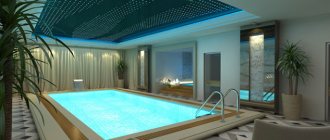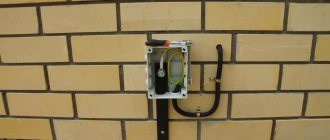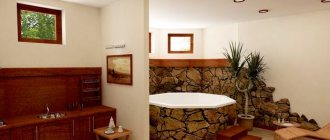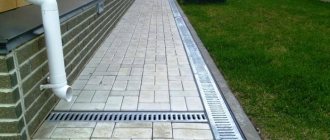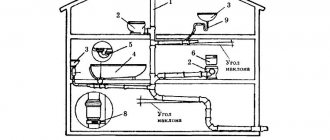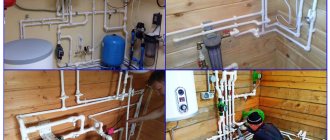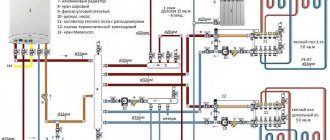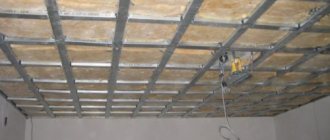A swimming pool in a residential building is attractive because it can be used regardless of weather conditions and other external factors. It is located in a warm place and does not experience any influence from nature. However, its work depends entirely on how the construction goes, whether the project meets the basic requirements, and in what part of the house you decide to build this structure for yourself.
A swimming pool in a country house can be located in almost any part of it, even on the roof or in the basement. Often, owners prefer to install it next to the sauna. The main thing is to take into account all the nuances of construction and strictly follow the approved project.
§ Features of indoor pools.
Pools installed indoors are called indoor, indoor or indoor. Structurally, design options, materials used and equipment, the installation of a swimming pool in a house is almost no different from its counterparts installed in the open air. Pool bowls are also manufactured either on site or in a factory, after which they are delivered to the installation site. In the first case, they are made of concrete using classical (monolithic) or prefabricated technology (prefabricated reinforced concrete structures), from sheets of steel or polypropylene, followed by reinforcement with a cement screed. In the second case, polypropylene, polyvuplen (sheet polypropylene) or fiberglass are used.
The main difference between closed hydraulic structures lies in the following nuances. For their normal functioning and maintaining optimal climatic conditions, a whole range of engineering and technical communications should be provided. The latter include heating systems, hot and cold water supply, ventilation (if necessary, dehumidification), sewerage and electricity supply. This significantly increases the load on the home's utility networks and, therefore, requires the installation of more powerful equipment. Therefore, it is better to start deciding on the construction of a swimming pool in a private house at the initial stage of designing the building itself, since it is more difficult to do this in already constructed dwellings.
↑ At the request of the buyer, the pools are additionally equipped with various water attractions: waterfalls, fountains, geysers, counter-current systems, hydromassage, slides and springboards.
And although the construction of inland water reservoirs is associated with significant financial costs, they have a number of advantages that justify the investment. This is low energy consumption for heating water, no need for conservation for the winter and, perhaps most importantly, the possibility of their use throughout the year.
An indoor pool can be installed in almost any room. In accordance with the developed design documentation, the bowl is placed on the ground floor of the building, in the basement, or in an extension, and even on the upper floors and flat roof. To do this, provide a foundation and powerful perimeter cladding that can withstand design loads, maintaining the strength and integrity of the structure throughout its entire service life. This precaution helps prevent leaks. Sometimes a separate structure is erected for the reservoir, which is the best option.
Flaws
Of course, having your own indoor pond has its drawbacks, and there are things that need to be given more attention:
- Safety
- Content
A home pool can be dangerous for a variety of reasons. Starting from the fact that a person who cannot swim can fall into it, and ending with the unfortunate location of the structure. In the second case, the seriousness of the situation is aggravated by the fact that after construction it is difficult to correct anything, so all points must be taken into account at the design stage.
It is dangerous to make a pool on the second floor or roof with your own hands, since this requires more knowledge and skills than is shown even in the best video. Due to improper installation, supporting structures may break, and the lack of necessary ventilation will ruin any project.
Maintaining large-volume reservoirs with your own hands is as difficult as building them. It needs to be constantly cleaned, water quality monitored and ventilation monitored.
And yet, having your own pool in a country house and the opportunities it provides outweigh the few disadvantages. And if you decide to do this, start choosing in advance the appropriate location and design of your future personal pond.
§ Indoor pool project: main details.
The construction of swimming pools in private homes is a complex and labor-intensive process that requires a systematic approach. And the sooner you think about it, the technically easier and financially more economical the implementation of your intended plan will be. But it's not that simple.
The first difficulty faced by a potential buyer is the choice of a company that could provide a full package of services not only for design, waterproofing, interior finishing of the pool, reconstruction of the water tank and other related equipment, but also for carrying out auxiliary engineering and technical networks that provide optimal microclimate in the pool. As a rule, such companies are not found often. There are at least two ways out of this situation: searching for a broad-profile organization or parallel cooperation with several companies doing their part of the work, which, you see, is not always convenient.
When the issue with the company is resolved, they begin to develop an architectural and planning solution. Specialists are visiting the site. They calculate the complexity and volume of the upcoming work, do geodetic reconnaissance, determining the properties of the soil and groundwater level, as well as the dynamics of its fluctuations throughout the year. Based on the results obtained, it becomes known how suitable the allocated area is for constructing a structure deep in the ground, where to place it and what type of bowl is best to give preference.
If the pool room has already been built, they draw up a measurement drawing and prepare several extremely versatile options for the layout of the room, the size and shape of the bowl, determine the water recycling scheme (use of skimmers or overflow gutters), select filtration equipment and control automation.
At the same time, they are developing a project for ventilation and drainage of the pool, taking into account the construction plan of the building, the area of the water surface, the size of the room, the layout of communications, determining the required power of electrical equipment, the parameters of the heating unit, the temperature of the coolant, and providing a technical chamber. After approval of the project by the customer, installation work begins.
Filtration system
Considering that the water in any pool stagnates, which is why it can bloom and become cloudy, it is necessary to provide cleaning options. Leaves or insects that fall on the surface of an open reservoir are removed using a net. Water from small reservoirs can simply be drained.
Stationary and multi-cube pools require the installation of filtration systems. The shape of the bowl itself affects the preferred filtration option - skimmer or overflow.
Skimmer water purification system
The skimmer is preferable for a classic rectangular-shaped pool. The device removes the top layer of the water surface, and after cleaning, the water returns to the bowl through holes in the walls. This system is most suitable for private swimming pools.
Overflow cleaning system
An overflow pool differs from a skimmer pool by the level of the water surface. The water edge is at the level of the side, the water circulates all the time: clean water comes from the bottom, and at the top, overflowing the edge, the water enters the gutters and further into the cleaning system.
§ Determine the optimal size of the pool.
To determine the optimal size, depth and shape of the future water tank, you should find out what it will be used for, how many people it will be designed for, taking into account their belonging to a particular age group and swimming skills. For people with disabilities, special descents into the water are provided separately, equipped with auxiliary handrails and holders.
In the case of bowls built on site, there will be no difficulties; technology allows them to be made in any format. This provides ample opportunities for the implementation of the creative flight of design ideas and the fulfillment of the most non-standard wishes of the customer.
↑ The shape and dimensions of the bowl are chosen depending on its purpose. Hydromassage SPA is usually made with a small volume (1) - 6-8 cubic meters, swimming tanks (2) - spacious, up to 1.6 m deep. Undoubtedly, the benefits of a hydromassage SPA pool justify the cost of its equipment.
The situation is different with ready-made tanks. The range of manufacturers usually includes several serial models of a certain shape and several standard sizes. At the same time, not everyone takes on the implementation of a non-standard solution, the cost of which will be 15-25% higher. Thus, the dimensions of composite bowls vary from 2 × 2 × 1.5 m to 13 × 5.5 × 2.5 m (length-width-depth), and their volume is 6-180 cubic meters. The average optimal size of a swimming pool in a private house is 7 × 3.5 × 1.5 meters.
Indoor pools intended for medical purposes are traditionally made compact with a volume of 6-8 cubic meters, and are additionally equipped with hydromassage nozzles, which create a relaxing and healing effect. Swimming models are rectangular in shape with an average depth of 1.2-1.6 m. If it is used for diving, the depth is increased in accordance with the wishes of the owner of the house.
A prerequisite for arranging a pool is the presence of bypass paths (see photo below), provided along the entire perimeter of the bowl, with a slight slope in the direction opposite to its sides. This will prevent dirt from getting back into the reservoir. Their width varies from 0.4 to 1.25 m. This distance is quite sufficient for safe operation.
↑ The installation of a swimming pool in the house requires bypass paths. They are made with a slight slope in the direction opposite to the bowl. To improve ergonomics, tanks are equipped with steps and handrails, which greatly facilitate descent and exit from the water.
To save money
You can save on building materials during the construction of a swimming pool inside your home. For example, instead of expensive polypropylene, you can use hydrofilm. A durable film is applied to the erected frame and strengthened - first on the bottom, then on the side of the pool, leaving holes for filling and draining water, filtration, and cleaning. We coat the joints and top parts with sealants. Ceramic tiles are also cost-effective; porcelain stoneware; glass mosaic. If you want to save money and a country style suits your pool, you can line the walls and floor around the bowl with clapboard or weathered wooden slabs - waterproof and not subject to changes in humidity and temperature.
§ The importance of high-quality waterproofing.
Since indoor hydraulic structures are often located inside a building or located in close proximity to it, an important condition for their safe operation is high-quality waterproofing. This is especially true for reinforced concrete and panel structures, which do not represent a complete barrier to moisture. Over time, due to dynamic loads caused by water pressure inside the bowl and soil heaving in winter, temperature changes, microcracks can form in them, through which water will seep and erode the foundation, which is fraught with serious consequences.
Therefore, firstly, it is necessary to ensure that in the manufacture of the bowl, high-strength Portland cement grades 400-500 with waterproofing additives, resistant to frost and immune to the effects of sulfate ions, is used. Secondly, the walls of such tanks from the inside and outside are treated with elastic polymer-cement mastics, for example, Aquamat (Isomat SA, Greece), Ceresit CR 65 (Henkel Bautechnik, Ukraine).
They also provide additional protection provided by penetrating waterproofing. Its essence lies in the application of special compounds, for example, Cem-Kote CW Plus (Gemite, USA), Penetron (Penetron-Russia, Russia), which contain insoluble compounds that clog the pores of concrete. Also, for this purpose, all kinds of polymer films are used, for example, Flagpool (Flag, Italy), Alkorplan (Renolit, Belgium). Particular attention is paid to the joints and seams of the tank.
What materials are pool finishing made from?
The most common option is, of course, tiles with an anti-slip surface.
Other types of materials used by developers:
- Porcelain tiles;
- Mosaic;
- Wood-polymer composite decking board;
- Stone.
§ Microclimate in the pool: creating favorable conditions.
As you know, a fairly large amount of moisture evaporates through the water surface per day (on average 0.22 kg/hour per 1 sq. m at a water temperature of + 24.. +26 °C). The rate of moisture formation and its volume directly depend on the size of the tank, namely its surface area and depth, air flow speed and the temperature difference between the water in the bowl and the air in the room. The more pronounced this contrast is in favor of the reservoir, the more intense the evaporation.
↑ In order to be able to swim in indoor pools all year round, you need to carefully consider the heating system. The number, performance of heating devices and their location are determined depending on the volume of the room, the materials used and the area of the translucent part of the structure.
A negligent attitude towards this problem can ultimately result in serious problems. Firstly, high humidity, combined with a fairly warm air temperature, serves as a favorable environment for the development of microorganisms (bacteria and molds), which poses a threat to the health of the residents of the house. Secondly, condensation accumulating on the walls and ceiling can lead to premature destruction of the building.
The main burden of creating favorable climatic conditions in the pool room is borne by the supply and exhaust ventilation, dehumidification and heating systems. And the state of your health and the durability of the room itself will directly depend on how well their functional units are designed and installed. To ensure a normal microclimate, the water temperature is maintained at +26...+29 °C, the room is heated to +27...+31 °C. Air humidity should not exceed 50-65%, minimum air flow circulation - 80 cubic meters / hour per person.
The issue is approached in a comprehensive manner. The primary tasks of the ventilation system are to regulate humidity, prevent the formation of condensation, control the dew point, and ensure the flow of fresh air. A good help in this situation is automatic control.
↑ The location of the air ducts of climate systems is calculated so that they ensure uniform air circulation in the room.
Air duct communications are collected so that the moisture removed is isolated from other rooms of the house. Their location (top or bottom) is determined by the structural features of the building. In the room with the pool, a slight vacuum of air is created. The power units are taken to the technical room.
Depending on the technical requirements for the facility and the financial resources available to the owner of the house, supply and exhaust, exhaust, and supply ventilation equipment are installed. Along with advantages, each of the systems is not without disadvantages. They do not always sufficiently regulate the humidity in the room. When installing exhaust ventilation, fresh air enters the room through various cracks in the building. The weaknesses of air supply units include the not entirely effective removal of exhaust air.
Stages of pool construction
Developers distinguish three main stages:
Choosing a site for construction
Obviously, if you are going to build a pool on a plot, you have enough free space on it. However, before you start digging in a certain place, it is important to consider several nuances.
Make sure that no utilities - gas pipeline, water supply, sewerage - pass under the future building before starting excavation work.
It is strongly recommended to invite a construction expert who will study all the features of the site and the location of the future building, whether there are any restrictions, whether a drainage system is necessary under the object, or whether any additional measures will be needed to strengthen the foundation of the building at the site of the pool construction.
Also take into account the characteristics of your climate, average air temperature, amount of precipitation, prevailing wind directions, and the number of sunny days.
As a rule, few homeowners think about how to position the pool relative to the cardinal directions. And in fact, is this really important? It turns out that yes!
Imagine any house. Some side always heats up more and some side heats up less. And in the evening the sun sets. You should take into account that some part of the pool bowl should be located either to the west or to the east. Well, or to both sides at the same time!
Wind is almost as important a factor in choosing a location for an outdoor pool as the sun. A strong wind will be unpleasant on a cool day, but vice versa on a very hot day. Wind also carries away pool heat and causes increased evaporation of chemicals from the water.
This is why it is important to install your pool so that it takes advantage of the wind. You can and should control the wind! To do this, use fences, screens, trees or plants. You can grow a whole grove around your oasis and dispel the wind.
Installing a pool bowl
At this stage, a concrete pool bowl is made, or polypropylene or composite bowls are installed in the pit. Pipelines and water circulation systems are supplied to the facility.
This engineering equipment is installed on a site prepared for it or in a room. Experts will recommend to you what utilities need to be brought to this place (water, electricity, sewerage, heating).
Interior decoration
It is different for each type of pool. In concrete structures, these are mosaics, tiles, and films. Polypropylene and composite pools are installed immediately as a whole, as a single structure.
Once all the work is completed, the pool is filled with water and the developers complete the finishing work according to your ideas.
The final touch is to add toys and place comfortable furniture near the pool. Congratulations! You have now created a fabulous family retreat that you can enjoy for many years to come.
§ Automated pool drainage systems.
When the ventilation system cannot cope with the removal of moist air from the room, to maintain an optimal microclimate in the pool, automatic dehumidifiers are additionally used, which are equipped with built-in or remote sensors and a timer. They can be floor-mounted, wall-mounted (designed for an area of up to 20 sq. m.) or channel (for indoor pools up to 40 sq. m. in area). Separate use of these devices is impractical, because - although it is possible to eliminate moisture - there is no air circulation, which is bad for enclosed spaces. The most successful option is a combination of supply and exhaust ventilation and a dehumidification system. But such a solution is not cheap.
The operating principle of dehumidifiers is as follows. A powerful fan sucks in moisture-rich air. Passing through the heat exchanger, it cools until condensation forms, which is subsequently removed into the sewer. Next, after preheating, the dried air is supplied back to the room. That's the whole principle.
Using special tables, the required equipment power is found, which varies from 60 to 900 W. Productivity is determined by the amount of condensate removed, which for household devices is 10-100 l/day. The number and location of drying installations are determined by the calculation method, taking into account the area of the water surface (m2).
↑ Compact wall-mounted or floor-mounted dehumidifiers help maintain optimal moisture levels. To prevent condensation from forming on the windows, dehumidifiers are installed near them.
These devices are placed directly in the room with the pool or in the equipment room, for which air ducts are provided. To avoid short circuits they are grounded. As you can see, drainage is an important part of swimming pool operation.
Ventilation equipment is quite widely represented on the domestic market. Depending on the needs of customers, you can choose the most optimal solution for each specific case. This can be a supply and exhaust system, for example, EPVS-200 (Electrolux, Sweden, price - $550), Eco-V (LG, Korea, price - $2400), supplemented with dehumidifiers, for example, Dantherm (Denmark, from $1300), Neoclima (Greece, price from $2000) or a system with three-stage heat recovery designed for dehumidification and ventilation, for example, Aquavent DPH-WP (Frivent, Austria), or an installation with the possibility of heating, humidification and ventilation, for example, ThermoCond (Menerga, Germany ).
Advantages of stationary pools
It is important to understand that for active swimming, water procedures, as well as active entertainment, only a concrete or polypropylene pool is suitable. In order for the structure to withstand the weight of water, special reinforcement is used in all planes, taking into account the configuration of the bottom, which can be flat or sloped. The advantages of turnkey capital pools include the following:
- no restrictions on overall dimensions and depth;
- the ability to design a pool bowl of any shape;
- resistance to any physical impact
- long service life - over 40 years;
- compliance with the strictest sanitary and epidemiological requirements;
- the ability to finish in the desired style and design: tiles, mosaics, polymer coatings made of composite materials, PVC film and so on.
By ordering the construction of a swimming pool, you get a unique opportunity to become one of those people who will successfully make your old dream come true. By the way, having a full-fledged swimming pool on your property significantly increases the price of land, therefore, it is also a profitable investment in the future.
§ Market offers: manufacturing companies, prices.
Many companies are engaged in the development of indoor pool projects, their manufacture and installation. Among them, “Aqua-Lux”, “Albion”, “Aspar Pool”, “Water World” (Fiber Pools brand), “Vseslav”, “Gallery Pools”, “DMV”, “Orion GEO”, “Premium Aqua” are well known ", "Yuventa-group" (all - Ukraine). “Aspar Pool”, “A”, “Gallery Pools”, “DMV”, “Steel Bowls” are specialized in the production of concrete tanks and are represented by the Astralpool trademark (Spain). Polypropylene tanks are manufactured by Albion and Aspar Pool. Reservoirs (bowls) made of polyvuplen (sheet polypropylene) are made by Albion. Fiberglass bowls are produced by “Water World” and “Orion GEO”. Ready-made fiberglass tanks are also represented by foreign brands, such as: Astralpool (Spain), Compass Pools (Australia), Jean Desjoyaux (France). Depending on the dimensions, materials of manufacture, preliminary work, complexity of the design and the set of associated equipment, prices for fully equipped indoor pools (“turnkey”) start from approximately 6 thousand dollars.
CM. MORE: calculation of the cost of a swimming pool.
Dear reader, please rate the article 
2.6666666666667 Rating 2.67 (27 Votes)
What to read on the topic:
- 11/17/2015 — Plumbing for children. Ideas for arranging a children's bathroom
- 11/17/2015 — Sewer septic tanks for a private country house
- 11/17/2015 — Shower panels with hydromassage. Models, prices. Panel installation
- 11/17/2015 — How to arrange a bathroom comfortably, quickly and inexpensively
- 11/17/2015 — How I made a shower in a bathhouse at the dacha. Design and operation of the shower
How to install a pool
After studying the features of the site and drawing up project documentation, a design is developed, a discussion with the client of the future shape, the choice of construction and finishing materials takes place. Next, a whole range of installation work is carried out, implying the following stages:
- Creating a pit for a swimming pool.
- Preparing the base for concrete screed or composite material.
- Installation of formwork, which allows you to determine the clear geometry of the future structure.
- Reinforcement of the bowl and installation of niches and holes for embedded elements: nozzles, hoses, etc.
- Concreting using concrete mixtures with high technological properties.
- Leveling the applied layer and installing embedded elements.
- Treatment of the surface of the bowl with polymer compounds to ensure the tightness of the structure.
- Carrying out finishing work, decoration, installation of stairs, handrails.
- Putting the finished structure into operation, filling the bowl with water, testing the operation of the filter.
Planet Pools LLC knows a lot about creating ideal, long-lasting pools. If you are still looking for experienced specialists, then you definitely need to contact us, because we create reliable swimming pools for wellness and entertainment.
Our company organizes the construction of swimming pools of any complexity - commercial and for private use (dachas, cottages, private houses). If you need to build a swimming pool, we are ready to provide a free consultation on a preliminary cost calculation and expert assessment of the construction.
Prices
Economy option
| № | Item name | Unit | Price, rub. |
| 1. | Project | — | 25 000 |
| 2. | Filling the bowl | 17 cubic meters | 382 500 |
| 3. | Leveling the surface of the pool bowl (walls, bottom) with sand-cement mortar with the addition of chemicals | 78 sq.m. | 58 500 |
| 4. | Waterproofing LITOKOL 2-layer | 80 sq.m. | 68 000 |
| 5. | Installation of embedded elements in technological niches and embedding with non-shrink mortar | 6 pcs. | 18 000 |
| 6. | Filtration system EMAUX FSF 500 | — | 31 680 |
| 7. | Chlorine dispenser EMAU CL01 | — | 8 460 |
| 8. | Pipes, taps, fittings | 1 kit | 24 000 |
| 9. | Skimmer EMAUX standard plastic | 2 pcs. | 4 400 |
| 10. | Bottom drain POOL KING plastic | 1 PC. | 820 |
| 11. | Wall nozzle POOL KING plastic | 4 things. | 2 320 |
| 12. | Filtration control unit S.S.E.I DO-F | — | 7 250 |
| 13. | PAHLEN thermostat | — | 6 800 |
| 14. | Installation of embedded elements in technological niches | — | 12 200 |
| 15. | Solenoid valve Tork NC 3/4″ | — | 3 800 |
| 16. | Circulation pump GILEX 25/40 | — | 3 500 |
| 17. | Installation of equipment | — | 22 190 |
TOTAL TURNKEY: 653,420 rubles
Construction period from 2 months
The price is indicated without the cost of sand-cement mortar with the addition of chemicals, waterproofing, finishing materials and finishing work. * — The cost of a cube of concrete includes: formwork, concrete, reinforcement and labor.
Option standard
| № | Item name | Unit | Price, rub. |
| 1. | Project | — | 25 000 |
| 2. | Filling the bowl | 17 cubic meters | 382 500 |
| 3. | Leveling the surface of the pool bowl (walls, bottom) with sand-cement mortar with the addition of chemicals | 78 sq.m. | 58 500 |
| 4. | Waterproofing LITOKOL 2-layer | 80 sq.m. | 68 000 |
| 5. | Installation of embedded elements in technological niches and embedding with non-shrink mortar | 7 pcs. | 21 000 |
| 6. | Filtration unit 10 m3/h Kripsol Toledo | — | 63 650 |
| 7. | pH,Rx dosing and control system - POOL GUARD 1 | — | 134 860 |
| 8. | Pipes, taps, fittings | 1 kit | 24 000 |
| 9. | Skimmer for tiles Aquasector | 2 pcs. | 42 400 |
| 10. | Bottom drain under tiles Aquasector | 1 PC. | 4 560 |
| 11. | Water level regulator stainless steel Xenozone steel | — | 8 200 |
| 12. | Xenozone tile feed nozzle (FP.091.7) | 4 things. | 7 600 |
| 13. | Filtration and heating control unit DARIN NAVIGATOR TIMER | — | 28 000 |
| 14. | Tube for temperature sensor RT 1000 | 1 PC. | 2 700 |
| 15. | Heat exchanger 40 kW Pahlen MAXI-FLOW | 1 PC. | 19 000 |
| 16. | Solenoid valve Tork NC 1" | — | 4 200 |
| 17. | Circulation pump WILO STAR-RS 25/4 | — | 6 600 |
| 18. | Installation of equipment | — | 77 865 |
TOTAL TURNKEY: 978,625 rubles
Construction period from 2 months
The price is indicated without the cost of sand-cement mortar with the addition of chemicals, waterproofing, finishing materials and finishing work. * — The cost of a cube of concrete includes: formwork, concrete, reinforcement and labor.
Premium option
| № | Item name | Unit | Price, rub. |
| 1. | Project | — | 25 000 |
| 2. | Filling the bowl | 17 cubic meters | 382 500 |
| 3. | Leveling the surface of the pool bowl (walls, bottom) with sand-cement mortar with the addition of chemicals | 78 sq.m. | 58 500 |
| 4. | Waterproofing LITOKOL 2-layer | 80 sq.m. | 68 000 |
| 5. | Installation of embedded elements in technological niches and embedding with non-shrink mortar | 6 pcs. | 18 000 |
| 6. | Filtration unit 13 m3/h Behncke Cristall | — | 77 200 |
| 7. | Dosing station Dinotec Poolcontrol DYNAMICS Professional Cl/Rx/pH | — | 330 600 |
| 8. | Pipes, taps, fittings | 1 kit | 24 000 |
| 9. | Ozone generator Dinotec DIN-O-ZON | — | 665 000 |
| 10. | Skimmer for tiles Pahlen | 2 pcs. | 95 900 |
| 11. | Bottom drain under tiles Aquasector | 1 PC. | 4 560 |
| 12. | Nozzle feeding under tiles Aquasector (AS 07.021) | 4 things. | 24 000 |
| 13. | Filtration and water level control unit Combitrol LEVEL 220V | — | 162 000 |
| 14. | Heat exchanger 50 kW Bowman, stainless steel tubes. become | 1 PC. | 29 250 |
| 15. | Solenoid valve Tork NC 1" | — | 4 200 |
| 17. | Circulation pump WILO STAR-RS 25/4 | — | 6 600 |
| 18. | Installation of equipment | — | 325 000 |
TOTAL TURNKEY: 2,300,810 rubles
Construction period from 2 months
The price is indicated without the cost of sand-cement mortar with the addition of chemicals, waterproofing, finishing materials and finishing work. * — The cost of a cube of concrete includes: formwork, concrete, reinforcement and labor.
Private pool: varieties and design
The trend for a healthy lifestyle has firmly entered our everyday life. Taking care of your well-being is as important an aspect for a successful person as personal and financial well-being.
Against the backdrop of general activity and the desire for proper time management, the popularity of home aquazones is not surprising. It is convenient to use a personal pool or sauna at any time, and the absence of strangers and hygiene allow you to relax as much as possible.
Wood trim on the ceiling and floor sets the style of this pool with arched windows
Creating a swimming pool requires the work of a whole group of professionals, from technicians to designers. The best option would be to plan the pool area at the same time as the overall house design. This approach will ensure proper preparation of premises, building materials, engineering components and, of course, visual harmony of the entire living space.
Indoor pool with geometric columns and second light
This primarily applies to pit-type pools, since inflatable and frame pools are installed with minimal preparation.
